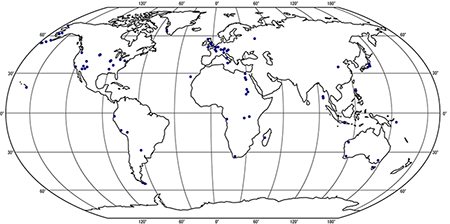
DATA SET
PLEASE READ THIS PAGE BEFORE DOWNLOADING THE DATA SET

ABOUT THE DATA
The Goldman Data Set consists of osteometric measurements taken from 1538 human skeletons dating from throughout the Holocene. Links to the data are at the bottom of this page. Links to sample provenience and dating information may be found in links below. Measurements were taken bilaterally from four of the long bones: humerus, radius, femur, and tibia. Three measurements were additionally obtained from the pelvis. Sex and age were estimated as well from pelvic observations (see Auerbach and Ruff, 2004, and Auerbach and Ruff, 2006, for a description of the methods employed).
Dr. Benjamin Auerbach obtained all of these data during three solo research trips beginning in September 2001 and ending in July 2003. These trips were made possible as part of a research fellowship provided by generous funding from the Joanna Jackson Goldman Memorial Prize; the data set is named after this organization. Dr. Auerbach continues to be grateful to the staff and curators at the institutions in the United Kingdom, Italy, Austria, Germany, France, Belgium, the United States of America, and Japan for allowing permission to work with their collections. A list of source institutions may be found below.
These data are now made available to researchers for download. The data are available below as a Microsoft Excel legacy file and as a comma-separated text file. A supporting document describing the osteometric measurements is also provided as a PDF file. Additional provenience information for the samples is currently available by request from Dr. Auerbach.
ALL RESEARCHERS WHO PLAN TO USE THESE DATA ARE WELCOMED AND ENCOURAGED TO CONTACT DR. AUERBACH. ANY USE OF THESE DATA IN PRESENTED OR PUBLISHED RESEARCH CARRIES THE STIPULATION THAT THE SOURCE OF THE DATA BE CITED. ACCEPTABLE CITATIONS FOR THE DATA INCLUDE THE REFERENCE OF THE DATA’S ANALYSIS (AUERBACH & RUFF, 2004 or 2006) AND OF THIS WEB SITE.
ADDITIONAL INFORMATION ABOUT THE DATA
Description of the data set and measurements: PDF file
General dates of the sites sampled: Excel file
SPECIAL THANKS TO THE FOLLOWING INSTITUTIONS FOR PERMITTING ACCESS TO THEIR COLLECTIONS:
American Museum of Natural History, New York
Cleveland Museum of Natural History, Cleveland
Duckworth Collection, The University of Cambridge (LCHES), Cambridge
Institut Royal des Sciences Naturelles de Belgique, Brussels
Kent State University Department of Anthropology, Kent
Kyoto University (Kyodai), Kyoto
Musee de l'Homme, Paris
Muzeo Nationale di Antropologia e Etnologia, Florence
National Museum of Natural History (Smithsonian Institution), Washington, D.C.
Natural Histsory Museum, London
Naturhistorisches Museum, Vienna
Staatssammlung fur Anthropologie und Palaeoanatomie, Munich
Webb Osteology and Archaeology Collection, University of Kentucky, Lexington
DATA SET AND RELATED PUBLICATIONS
Goldman Osteological Data Set files (right-click and save file)
Microsoft Excel (XLS) file
Comma-separated values (CSV) file
Publications using data from the Goldman Data Set:
Auerbach BM, & Ruff CB. 2004. Human body mass estimation: a comparison of “morphometric” and “mechanical” methods. American Journal of Physical Anthropology 125:331-342.
Auerbach BM, & Ruff CB. 2006. Limb bone bilateral asymmetry: variability and commonality among modern humans. Journal of Human Evolution 50:203-218.
Temple DH, Auerbach BM, Nakatsukasa M, & Larsen CS. 2008. Variation in body proportions between Jomon foragers and Yayoi agriculturalists from prehistoric Japan. American Journal of Physical Anthropology 137:164-174.
Betti L, Von Cramon-Taubadel N, Lycett SJ. 2012. Human pelvis and long bones reveal differential preservation of ancient population history and migration out of Africa. Human Biology 84:139-152.
Plavcan JM. 2012. Body size, size variation, and sexual size dimorphism in Early Homo. Current Anthropology 53:S409-S423.
Stock JT. 2013. The skeletal phenotype of "Negritos" from the Andaman Islands and Philippines relative to global variation among hunter-gatherers. Human Biology 85:67-94.
Roseman CC & Auerbach BM. 2015. Ecogeography, genetics, and the evolution of human body form. Journal of Human Evolution 78:80-90.
Savell KRR, Auerbach BM, & Roseman CC. 2016. Constraint, natural selection, and the evolution of human body form. Proceedings of the National Academy of Sciences USA 113:9492-9497.
Meeting presentations using data from the Goldman Data Set:
Auerbach BM, & Ruff CB. 2003. Mass matters: an evaluation of two body mass estimation techniques in modern human populations. American Association of Physical Anthropologists Annual Meeting, Tempe, AZ. Abstract: American Journal of Physical Anthropology S36:61.
Auerbach BM, & Ruff CB. 2004. The right preferences? Bilateral Asymmetry in the upper and lower limbs of modern humans. American Association of Physical Anthropologists Annual Meeting, Tampa, FL. Abstract: American Journal of Physical Anthropology S38:56.
DeLeon VB, & Auerbach BM. 2007. Morphological integration in human long bones. American Association of Physical Anthropologists Annual Meeting, Philadelphia, PA. Abstract: American Journal of Physical Anthropology S44:96.
Auerbach BM & DeLeon VB. 2013. Developmental integration and functional integration in the human limbs: variation among humans and evolutionary implications. American Association of Anatomists Annual Meeting, Boston, MA. Abstract: FASEB Journal.
Roseman CC & Auerbach BM. 2014. Human body form is not distributed along a latitudinal cline. American Association of Physical Anthropologists Annual Meeting, Calgary, AB. Abstract: American Journal of Physical Anthropology.
Savell KRR, Auerbach BM, & Roseman CC. 2015. Selection gradients and ecogeographic variance in the human postcrania. American Association of Anatomists Annual Meeting, Boston, MA.